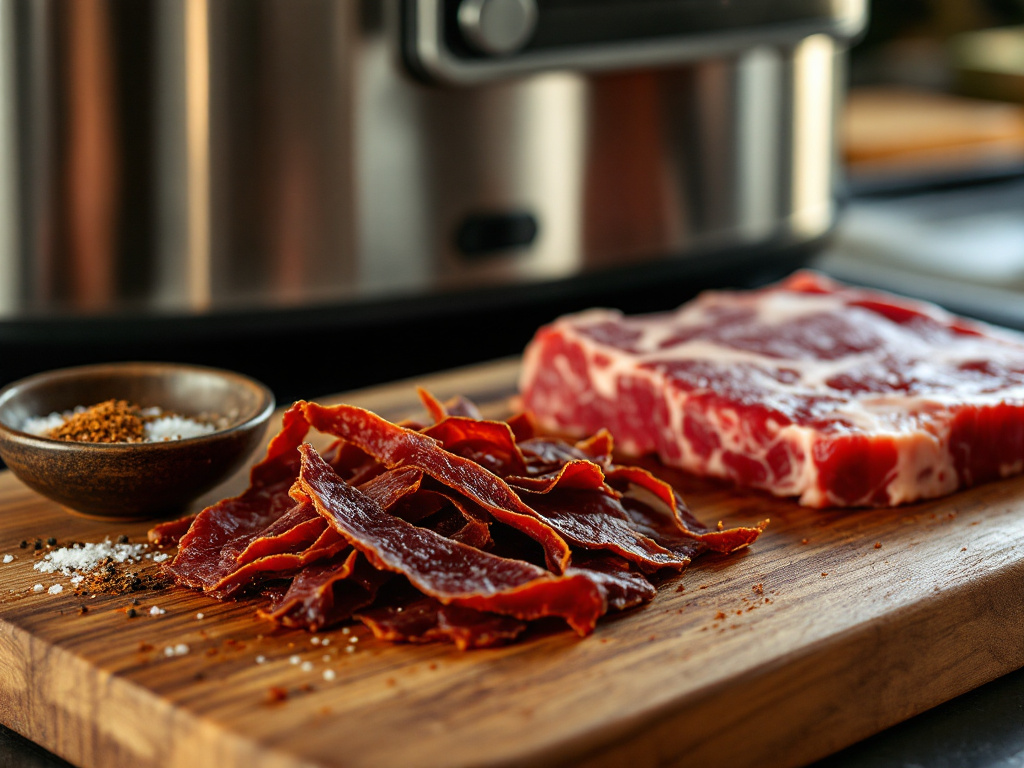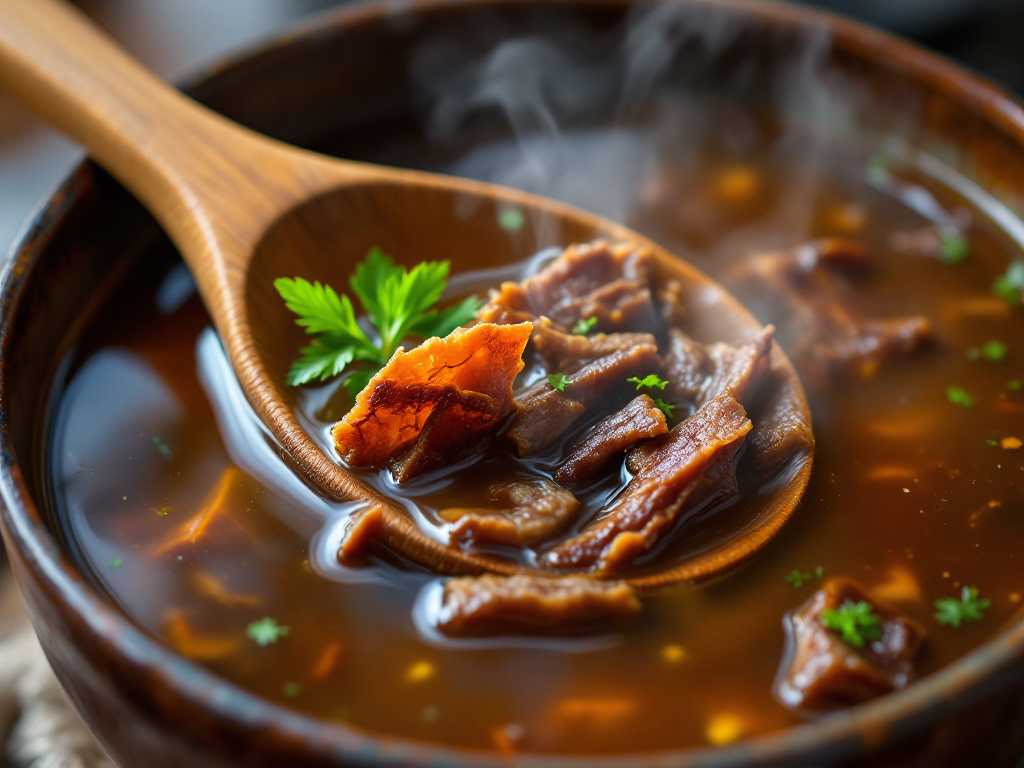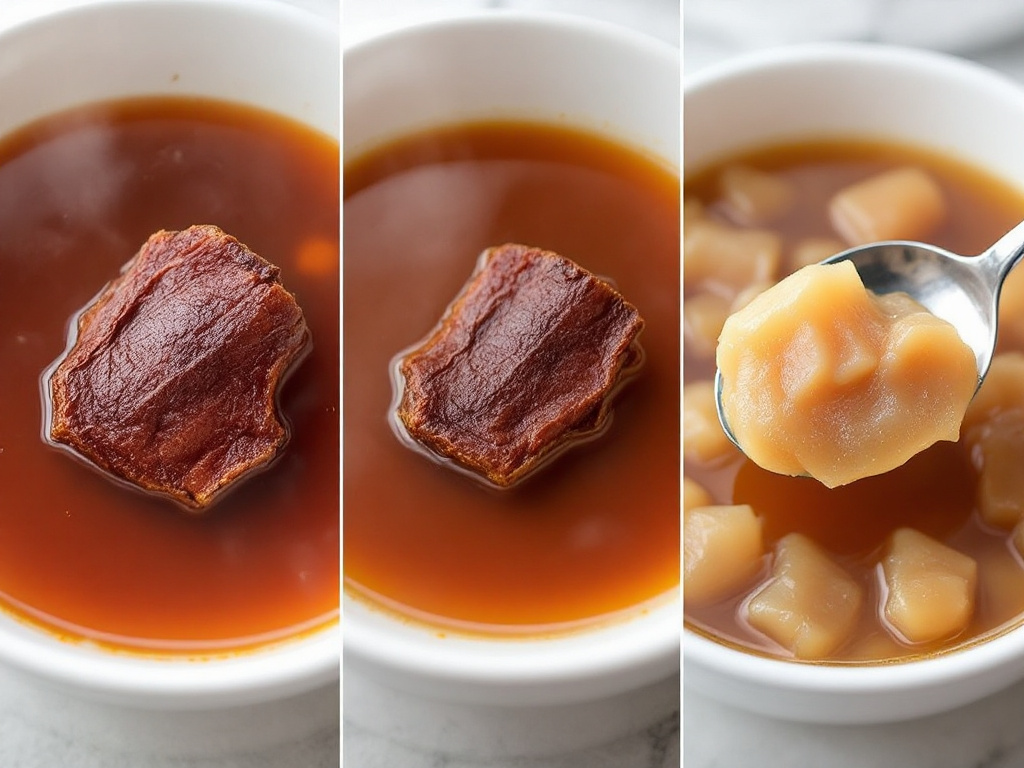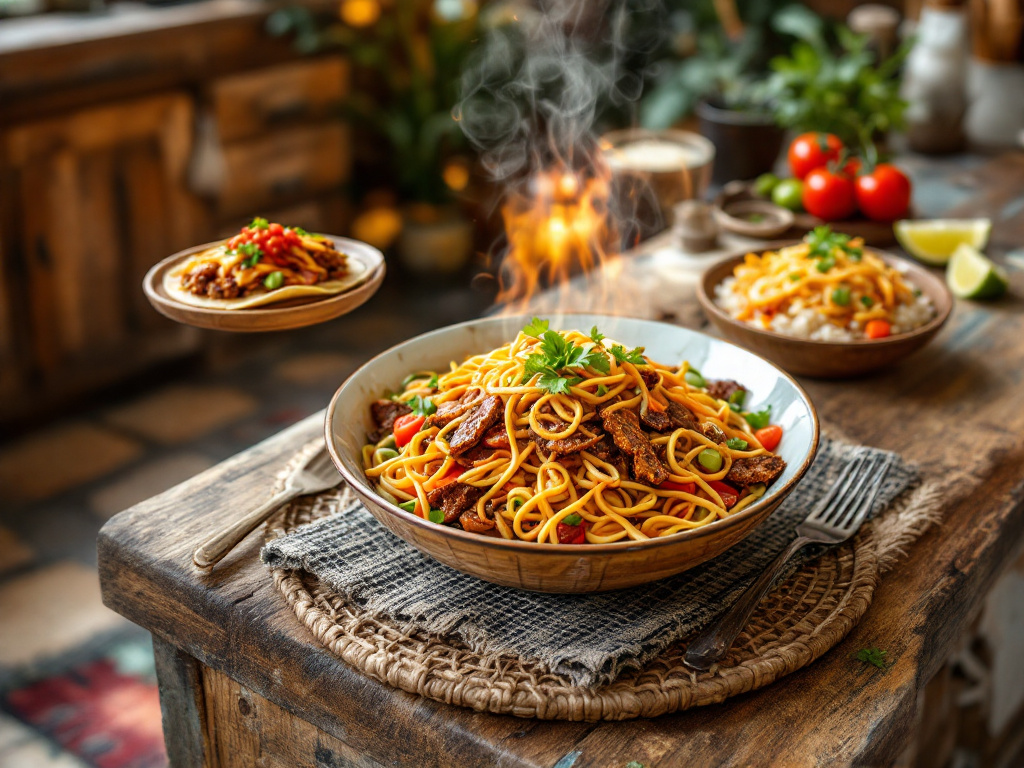Introduction
Beef jerky is a beloved snack known for its rich flavor and convenience. However, it can sometimes become too dry or tough, leading many to wonder if it’s possible to rehydrate beef jerky in soup. This article explores the process of rehydrating beef jerky, particularly in soup, and provides a comprehensive guide to enhancing its flavor and texture.
Understanding Beef Jerky

Beef jerky is a type of cured meat made from lean cuts of beef. The process involves marinating the meat in a mixture of spices and then dehydrating it to remove moisture. This preservation method has been used for centuries to extend the shelf life of meat. Beef jerky is not only a tasty snack but also a nutritious one, packed with protein and essential nutrients. For more insights into the culinary innovations with beef jerky, check out this article.
The process of making beef jerky involves several steps, including slicing the meat, marinating it, and then dehydrating it using a dehydrator or oven. The result is a chewy, flavorful snack that can be enjoyed on its own or used in various dishes. The nutritional benefits of beef jerky make it a popular choice among health-conscious individuals and outdoor enthusiasts. To learn more about the health benefits of beef jerky, visit this resource.
The History of Beef Jerky
Beef jerky has a rich history that dates back to ancient times. The process of drying meat to preserve it was used by various cultures around the world. In South America, the Quechua people, who were part of the ancient Inca Empire, created a product called “ch’arki,” which involved drying meat from llamas and alpacas. The term “jerky” is believed to have originated from this word.
In North America, Native American tribes also used similar techniques to preserve meat, particularly bison, which was a staple in their diet. This method of preservation was essential for survival, especially during long journeys or when food was scarce.
Modern Beef Jerky Production
Today, beef jerky is produced on a large scale using modern technology. The process involves carefully selecting lean cuts of beef, which are then sliced into thin strips. These strips are marinated in a blend of spices, soy sauce, and other flavorings before being dehydrated. The dehydration process can take several hours, depending on the thickness of the meat and the desired texture.
The result is a snack that is not only delicious but also convenient and portable. Beef jerky is a popular choice for hikers, campers, and anyone looking for a high-protein snack on the go.
Why Rehydrate Beef Jerky in Soup?

Rehydrating beef jerky in soup can significantly enhance its flavor and texture, making it more enjoyable to eat. Here are some reasons why you might want to rehydrate beef jerky in soup:
-
Improved Texture: Rehydration can soften the meat, making it easier to chew and more palatable. This is particularly useful if the jerky has become too dry or tough over time.
-
Enhanced Flavor: The process can infuse the jerky with additional flavors, especially when using liquids like broth or wine. This can add depth and complexity to the taste of the jerky.
-
Versatility in Cooking: Rehydrated beef jerky can be used in a variety of dishes, from soups and stews to noodles and rice. This versatility makes it a valuable ingredient in the kitchen.
-
Nutritional Benefits: Rehydrating beef jerky can make it easier to digest, allowing your body to absorb its nutrients more efficiently. This can be particularly beneficial for those with digestive issues or who are looking to maximize the nutritional value of their food.
The Science Behind Rehydration
Rehydration is the process of adding moisture back into dehydrated food. When beef jerky is dehydrated, the moisture content is significantly reduced, which helps to preserve the meat and prevent bacterial growth. However, this also makes the meat tough and chewy.
By rehydrating the jerky in soup, you are essentially reversing this process. The moisture helps to break down the tough fibers in the meat, making it softer and more tender. This process can also help to release the flavors in the jerky, making it more enjoyable to eat.
Methods of Rehydrating Beef Jerky in Soup

Microwave Method
The microwave method is a quick and efficient way to rehydrate beef jerky. Here’s how to do it:
- Place the jerky in a microwave-safe container with a lid.
- Add a small bowl of water or a moist towel to the container.
- Microwave at one-minute intervals, checking the texture until it reaches the desired softness.
- Enjoy immediately to prevent it from drying out again.
Pros:
- Quick and convenient.
- Maintains the original flavor of the jerky.
Cons:
- Can dry out quickly if not consumed immediately.
- May not be suitable for large quantities.
Soaking Method
Soaking beef jerky in liquid is another effective rehydration technique. Here’s how to do it:
- Submerge the jerky in a liquid such as water, broth, soup, or wine.
- Let it soak for 15-30 minutes, depending on the desired texture.
- Remove from the liquid and pat dry with a paper towel.
Pros:
- Allows for flavor infusion from the soaking liquid.
- Suitable for larger quantities of jerky.
Cons:
- Takes longer than the microwave method.
- May dilute the original flavor of the jerky if not monitored carefully.
Slow Cooker Method
Using a slow cooker is an excellent way to rehydrate beef jerky, especially if you plan to use it in stews or braises. Here’s how to do it:
- Place the jerky in the slow cooker with enough liquid (such as broth or water) to cover it.
- Cook on low heat for several hours, until the jerky is tender and rehydrated.
- Use the rehydrated jerky in your favorite stew or braise recipe.
Pros:
- Ideal for large quantities of jerky.
- Infuses the jerky with rich flavors from the cooking liquid.
Cons:
- Takes longer than other methods.
- Requires a slow cooker.
Sautéing Method
Sautéing is a quick and flavorful way to rehydrate beef jerky. Here’s how to do it:
- Heat a small amount of oil or butter in a pan over medium heat.
- Add the jerky to the pan and cook, stirring occasionally, until it reaches the desired texture.
- You can also add vegetables or spices to the pan to enhance the flavor of the jerky.
Pros:
- Quick and adds flavor to the jerky.
- Allows for customization with different ingredients.
Cons:
- Requires constant attention to prevent burning.
- May not be suitable for large quantities.
Rehydrating Beef Jerky in Soup
Rehydrating beef jerky in soup is a delicious way to incorporate it into a meal. Here are some tips and recipes to try:
-
Add to Soup: Simply add the jerky to your soup as it simmers. The liquid will rehydrate the meat, infusing it with the soup’s flavors. This method is particularly effective for hearty soups like beef and vegetable or minestrone.
-
Beef Jerky and Vegetable Soup: Combine rehydrated beef jerky with your favorite vegetables for a hearty and nutritious soup. Start by sautéing onions, carrots, and celery in a pot. Add the jerky and your choice of broth, and let it simmer until the jerky is tender.
-
Spicy Beef Jerky Soup: For a kick, add rehydrated beef jerky to a spicy tomato-based soup. Start by sautéing onions, garlic, and your choice of peppers. Add the jerky, diced tomatoes, and your choice of spices, and let it simmer until the jerky is tender.
Creative Soup Ideas
-
Beef Jerky and Mushroom Soup: Combine rehydrated beef jerky with mushrooms, onions, and garlic for a rich and earthy soup. Add your choice of broth and let it simmer until the jerky is tender.
-
Beef Jerky and Lentil Soup: Add rehydrated beef jerky to a hearty lentil soup for added protein and flavor. Start by sautéing onions, carrots, and celery. Add the lentils, jerky, and your choice of broth, and let it simmer until the lentils and jerky are tender.
-
Beef Jerky and Potato Soup: Combine rehydrated beef jerky with potatoes, onions, and garlic for a comforting and filling soup. Add your choice of broth and let it simmer until the potatoes and jerky are tender.
Creative Uses of Rehydrated Beef Jerky

Rehydrated beef jerky can be used in a variety of creative dishes. Here are some ideas to inspire your culinary adventures:
-
Stews and Braises: Add rehydrated beef jerky to your favorite stew or braise recipes for a rich, meaty flavor. The slow cooking process will help to further tenderize the jerky and infuse it with the flavors of the dish.
-
Noodle Dishes: Incorporate rehydrated beef jerky into noodle dishes for added protein and texture. Try adding it to stir-fries, ramen, or even mac and cheese for a unique twist.
-
Rice Bowls: Top your rice bowls with rehydrated beef jerky for a satisfying meal. Combine it with your favorite vegetables and sauces for a customizable and delicious dish.
-
Salads: Add rehydrated beef jerky to your favorite salads for added protein and flavor. Try combining it with leafy greens, cherry tomatoes, and your choice of dressing for a hearty and satisfying meal.
-
Sandwiches and Wraps: Use rehydrated beef jerky as a filling for sandwiches and wraps. Combine it with your favorite condiments and vegetables for a portable and delicious meal.
International Inspiration
-
Asian-Inspired Dishes: Use rehydrated beef jerky in Asian-inspired dishes like stir-fries, fried rice, or noodle bowls. The jerky can be marinated in soy sauce, ginger, and garlic for added flavor.
-
Mexican-Inspired Dishes: Add rehydrated beef jerky to Mexican-inspired dishes like tacos, burritos, or enchiladas. The jerky can be seasoned with chili powder, cumin, and lime for a bold and spicy flavor.
-
Mediterranean-Inspired Dishes: Incorporate rehydrated beef jerky into Mediterranean-inspired dishes like gyros, kebabs, or stuffed peppers. The jerky can be marinated in olive oil, lemon, and herbs for a bright and flavorful dish.
Health Benefits and Nutritional Value
Beef jerky is a nutritious snack that offers several health benefits:
-
High in Protein: Beef jerky is an excellent source of protein, which is essential for muscle repair and growth. This makes it a popular choice among athletes and fitness enthusiasts.
-
Rich in Vitamins and Minerals: Beef jerky is rich in vitamins and minerals, including iron, zinc, and B vitamins. These nutrients are essential for overall health and well-being.
-
Low in Fat and Calories: Beef jerky is low in fat and calories, making it a great snack for weight management. It is also low in carbohydrates, making it suitable for low-carb diets.
Rehydrating beef jerky can enhance its nutritional value by making it easier to digest and absorb its nutrients. This can be particularly beneficial for those with digestive issues or who are looking to maximize the nutritional value of their food.
Nutritional Profile
A typical serving of beef jerky (about 1 ounce or 28 grams) contains:
- Calories: 80-90
- Protein: 9-11 grams
- Fat: 1-3 grams
- Carbohydrates: 1-3 grams
- Sodium: 500-600 milligrams
Beef jerky is also a good source of:
- Iron: Essential for oxygen transport in the blood.
- Zinc: Important for immune function and wound healing.
- B Vitamins: Necessary for energy production and metabolism.
Health Considerations
While beef jerky offers many health benefits, it is also important to consider the following:
-
Sodium Content: Beef jerky can be high in sodium, which can contribute to high blood pressure and other health issues if consumed in excess. Look for low-sodium varieties or make your own jerky at home to control the sodium content.
-
Preservatives: Some commercial beef jerky products may contain preservatives, such as nitrates or nitrites, which have been linked to health concerns. Opt for natural or organic varieties that are free from these additives.
-
Allergens: Beef jerky may contain allergens, such as soy or wheat, depending on the marinade or seasoning used. Always check the label if you have food allergies or sensitivities.
Expert Tips for Rehydrating Beef Jerky in Soup
Here are some expert tips to help you achieve the best results when rehydrating beef jerky in soup:
-
Avoid Over-Soaking: Soaking the jerky for too long can make it mushy and lose its flavor. Monitor the jerky closely as it rehydrates to prevent this from happening.
-
Use Flavorful Liquids: Experiment with different liquids like broth, wine, or beer to infuse the jerky with unique flavors. This can add depth and complexity to the taste of the jerky.
-
Monitor the Process: Keep an eye on the jerky as it rehydrates to prevent overcooking or drying out. This is particularly important when using methods like sautéing or microwaving.
-
Customize Seasonings: Don’t be afraid to get creative with seasonings and marinades when rehydrating beef jerky. This can help to enhance the flavor of the jerky and make it more enjoyable to eat.
Common Mistakes to Avoid
-
Not Using Enough Liquid: When rehydrating beef jerky, it is important to use enough liquid to fully submerge the meat. Using too little liquid can result in uneven rehydration and dry spots.
-
Rehydrating for Too Long: Rehydrating beef jerky for too long can make it mushy and unappetizing. Monitor the jerky closely and remove it from the liquid once it reaches the desired texture.
-
Using High Heat: When rehydrating beef jerky using methods like sautéing or microwaving, be careful not to use too high of a heat. This can cause the jerky to become tough and chewy.
Storing Rehydrated Beef Jerky
Proper storage is essential to maintain the quality and freshness of rehydrated beef jerky:
-
Store in an Airtight Container: Store rehydrated beef jerky in an airtight container in the refrigerator to prevent it from drying out or absorbing odors from other foods.
-
Consume Within a Few Days: For the best flavor and texture, consume rehydrated beef jerky within a few days. After this time, the jerky may start to dry out or lose its flavor.
-
Avoid Freezing: Freezing rehydrated beef jerky can affect its texture, making it tough and chewy. It is best to store it in the refrigerator and consume it within a few days.
Long-Term Storage Tips
-
Dehydrate Again: If you have more rehydrated beef jerky than you can consume within a few days, consider dehydrating it again to extend its shelf life. This can be done using a dehydrator or oven, following the same process as when you made the jerky originally.
-
Vacuum Seal: For even longer storage, consider vacuum sealing the rehydrated beef jerky before freezing. This can help to prevent freezer burn and extend the shelf life of the jerky.
FAQs
-
Can you rehydrate beef jerky back into raw meat?
- No, rehydrating beef jerky will not turn it back into raw meat. The process of making jerky involves cooking and dehydrating the meat, which changes its structure and texture. Rehydrating the jerky can restore some of its moisture and tenderness, but it will not be the same as raw meat.
-
What happens if you put jerky in water?
- Putting jerky in water will rehydrate it, restoring some of its original texture and moisture. However, it may not taste the same as fresh meat. The water will help to soften the jerky and make it more tender, but it may also dilute some of the flavors.
-
Can you overcook jerky in a dehydrator?
- Yes, it’s possible to overcook jerky in a dehydrator, resulting in a dry and crumbly texture. Monitor the jerky carefully during the dehydration process to prevent this from happening. Overcooked jerky can be tough and difficult to chew, so it’s important to remove it from the dehydrator once it reaches the desired level of dryness.
-
Is there a way to soften beef jerky?
- Yes, you can soften beef jerky by rehydrating it using methods like soaking in liquid or microwaving it with water. This process helps to restore some of the moisture to the jerky, making it more tender and easier to chew.
Conclusion
Rehydrating beef jerky in soup is a great way to enhance its flavor and texture, making it a versatile ingredient in various dishes. Whether you prefer the quick microwave method or the flavor-infusing soaking technique, there are plenty of ways to enjoy rehydrated beef jerky. Experiment with different recipes and methods to find your favorite way to incorporate this delicious snack into your meals.
With its high protein content and rich flavor, beef jerky is a popular choice for snacks and meals. By rehydrating it in soup, you can unlock even more culinary possibilities and enjoy this tasty treat in new and exciting ways. So go ahead and give it a try – your taste buds will thank you!